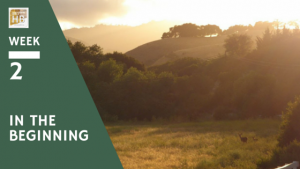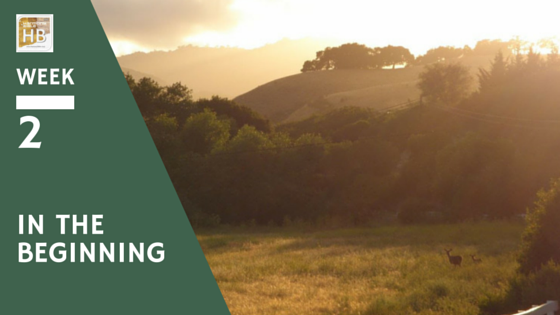Week 2 | Section 2
 As we continue our chronological study through the Gospels we turn to the Gospel according to John and read his prologue. John’s style of writing is unique as is the voice of every Gospeler1 John highlights: the deity of Christ, and the important distinction of our own humanity and the existence of God the Creator:Created, Incarnation.2
As we continue our chronological study through the Gospels we turn to the Gospel according to John and read his prologue. John’s style of writing is unique as is the voice of every Gospeler1 John highlights: the deity of Christ, and the important distinction of our own humanity and the existence of God the Creator:Created, Incarnation.2
Scripture:
John 1:1-18
1 In the beginning3¯4 was the Word, and the Word was with God, and the Word was God. 2 The same was in the beginning with God. 3 All things were made through him. 5¯6 Without him, nothing was made that has been made. 4 In him7 was life, and the life was the light of men.5 The light shines in the darkness,8 and the darkness hasn’t overcome it. 6 There came a man, sent9 from God, whose name was John. 7 The same came as a witness, that he might testify about the light, that all might believe10 through him. 8 He was not the light, but was sent that he might testify about the light. 9 The true light11 that enlightens everyone was coming into the world.12 10 He was in the world,13 and the world was made through him, and the world didn’t recognize him. 11 He came to his own,14 and those who were his own didn’t receive him.12 But as many as received him, to them he gave the right to become God’s children, to those who believe15 in his name: 13 who were born not of blood, nor of the will of the flesh, nor of the will of man, but of God.14 The Word16 became flesh, and lived among us. We saw his glory, such glory as of the one and only Son of the Father, full of grace and truth. 15 John testified about him. He cried out, saying, “This was he of whom I said, ‘He who comes after me has surpassed me, for he was before me.’ ” 16 From his fullness we all received grace upon grace. 17 For the law was given through Moses. Grace and truth17 were realized through Jesus Christ. 18 No one has seen God at any time. The one and only Son, who is in the bosom of the Father, he has declared him.18
Study Notes:
- While all four of the canonical Gospels tells the story of Jesus, each gospeler has their own voice that results in a slightly different account. This is much the same as when your friend recounts an event you both witnessed differently than you. Its no surprise. You stood or sat in one place and your friend in another; you have your life history that filters your listening and emotional responses as does your friend; you are communicating the event to one person and your friend is communicating it to another. Its perfectly acceptable that the same vent is told differently. John and his brother James were sons of Zebedee and Salome. The two were among the Twelve Apostles. He was a Jew familiar with the customs and feasts of Israel. He was an eyewitness of Jesus’ ministry observing Jesus’s life and ministry. Christian tradition holds that he outlived the remaining apostles and that he died between 89 AD to 120 AD. Scholars say the Book of John was written after the other Gospels between 80 and 95 A.D. as it was known and treasured by Clement the Bishop of Rome 92-99AD.John’s gospel account is centered on Jesus’ identity and mission, and his presence with us (John 1:1) by way of the incarnation (see: I am’s of Christ) and a personal relationship. John of whom authorship is granted, communicates the sincerity of their own relationship by calling himself “the disciple whom Jesus loved” (13:23). John was prominent in the early church but he never names himself in his Gospel. He was very familiar with the Jewish life, values, customs, geography, and beliefs.
- O Lord, God and Father, Thou knowest how blind we are to Thy presence, how dead to Thy purpose and deaf to Thy call, grant us to feel Thy guiding hand through all the scattered details of our daily life, in all the tumult to hear Thy still small voice, and in all dimness of our spirits to have a sense of Thine Everlasting arms up-bearing us; so that, being willing to spend and be spent in Thy service, we may accomplish in the perfect freedom of Thy sole sovereignty, through Jesus Christ Thy son our Lord. Amen.- A Chain of Prayer Across the Ages, 6th edition; p 284
- This is before time, before creation, before the story of creation recorded in Genesis and explained in the OT and NT. The Creation Story – The Bible is not a book of science but of faith, of culture, and of life (eternal & abundant). Scientists have evidence that our oldest known genetically common ancestor, ‘Mitrochondrial Eve‘, lived between 100,000 and 200,000 years ago in southern Africa. The oldest cave paintings (showing intelligent linguistics & communication) found to date are 40,000 years old, located in Sulawesi. What then is the creation story that is dated back only as far as 4000 years before Christ? Perhaps its is the DNA story of the Hebrew nation. The coming out and DNA roots of God’s chosen people, but one thing seems certain, it is not the story of the dawn of humanity as in from nothing. If it were science would give the same account. This phrase communicates that Jesus and the Father are one. The great I AM is HE and God’s essence is made visible in Jesus (“Anyone who has seen me has seen the Father,” 14:9). cf: Col 1:15, Matt 21:33-43. Jesus subjected Himself to human physicality through His incarnation (Hebrews 2:17,18; 4:14-16) and though He walked on earth, He was still (always) God, the eternal One (John 5:18; 8:56-59; 11:30-33; 20:28).the word <gk. logos, root of eng. logic>
- 4 transitions – signified by the gk word ἐγένετο Engento: to come into being, to happen, to become. Strongs #1096 (ginomai) means “to become, and signifies a change of condition, state or place” (Vine, Unger, White, NT, 109).The Creation Jn1:3; Then came John the Baptist Jn1:6; the incarnation Jn1:14; Crucifixion Jn1:17
- See World population estimates by Lambert Dolphin
- That Jesus was there with God at the creation of the world and in fact as he is one with God all things were made through him. Notice that John is not having to argue God’s creation of the world. This was a concept that was acceptable to John’s Jewish friends also widely accepted throughout the early church. Creation It’s important to understand that we can not come to a reasonable Christian view of creation by only reading the first three chapters of Genesis. Surely, the modern archaeological records are of great import, but I urge you to read more of the creation story throughout the OT (Proverbs, Job, Psalms, Isaiah, Jeremiah, and Ezekiel) and also those passages from the NT (Jn 1, Col 1:9-23; Hebrews 1:1-3, Rev 1:8).The Son of God was sent from the Father to finish the Father’s work in the world (Jn 4:34), and what he does glorifies the Father.
- In him the full grace and truth of God was in human form. See: “I am’s of Christ”. The Life and Life c.f. 1) John 5:26 – “…life in himself” 2) John 11:25 – I am the resurrection and the life. 3) 1 John 5:11-13 whoever has the Son has life. The sad truth is that many have closed their hearts, lives and minds to the light. They choose to abstain from being in it, they neglect it, or even oppose it having come to “love darkness” some “hate the light” because “their deeds were evil” (John 3:19-21).
- See verse 9 where in the Messiah was predicted as the “light” of the world. See also Isaiah 9:2; 43:1-3. With this great eternal light and power we learn that there is no need to fear. Why? God is God – above all other powers (Eph, 1:21; Eph 3:20; Phil. 2:9)
- John came as a witness to prepare people for the Christ. We too have a spiritual vocation and certain tasks that God desires us to to fulfill (Eph 4:11-13)Note: Ministry Discernment Survey available to our members.
- Believe that God’s eternal purpose is to be made possible again by Jesus. The eternal purpose will be made possible and completed through Christ. Because of his being, sacrifice and victory there is harmony with God and with all creation Col 1:17 – Gk sunistemi). Col 1:20 tells us that Jesus reconciled all things to himself by his death on the cross. If we believe it, then we can live it, stop our striving, ego, and errant and arrogant violence against God, one another and creation. This same harmony calls for us to abide in Christ (Jn 15). that by believing you may have life in His name.” (John 20:31).
- Jesus is the true light.
- John is speaking of the incarnation of Christ, see verse 10
- John is now expressing that the Messiah was already here and jumps through the time to the Gospel story quickly. He’s taken his listeners from “before time” to the present scenario – Christ (he=m. “logos”, vs “light” is neuter) was born and living but the world, nor his neighbors knew him (though they were amazed). While he gives us a historical summary in just nine verses, how wonderful it is that John gives his readers this bridge from what they had heard through the law and oral teachings to the time of his baptism.
- As the creator God all of creation is his own (his footstool as the psalmist wrote. The world and all that is in it.
- John makes makes a narrative summary of the condition of humanity, the work of Christ, the potential of the Gospel to those who receive him, who believe, to these he gives life abundant and eternal (John 10:10). The work of Christ is complete. The redemptive propitiation of all humanity is finished – but the power of such reality that results in a changed person is only as real as our acceptance and belief of such truths. Affect vs. Effect.
- John uses the word “logos” again directly as a transition in his prologue from verse 1 to 14 for the sake of his readers (disciples) who had seen and heard, accepted and believed.
- The Law was a tutor (Gal 3:24) to help mankind understand their inability to choose right, well and the path of love. The grace of God however has been provided to the world through Christ. John is speaking of the value of the law, not dismissing it, but recognizing its purpose and highlighting its limitation.
- Jesus, God the son, has made it plain to us (able to know) the nature, heart and will of God.
